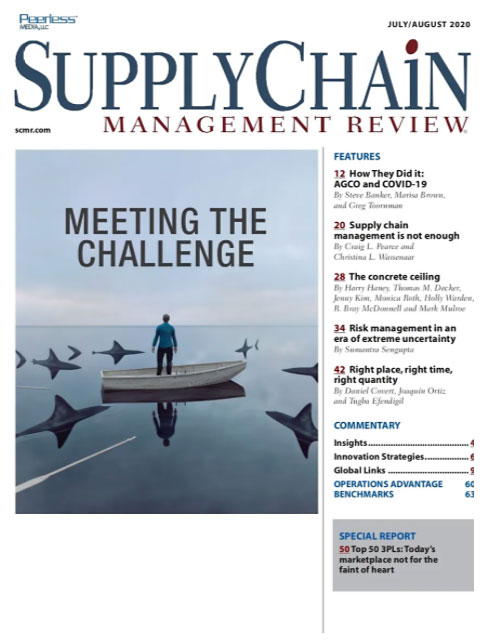Sorry, but your login has failed. Please recheck your login information and resubmit. If your subscription has expired, renew here.
July-August 2020
Supply chains have been in the news a lot the last couple of months, and not always for the right reasons. It seems as if the two words most often associated with supply chains these days are broken or failed, and supply chain is used to explain the shortages of everything from toilet paper to rib-eye steaks to personal protection equipment. Pundits question whether Amazon’s inability to make good on same-day and next-day deliveries or keep its endless shelves stocked during a pandemic will cost it market share. Browse this issue archive.Need Help? Contact customer service 847-559-7581 More options
In January 2020, a time when COVID-19 was barely on most companies’ radar, the supply chain team at AGCO, a leading manufacturer of agricultural equipment and replacement parts, began to hear from employees in China that something was happening in Wuhan, something that could put the supply of critical parts at risk.
Meeting the challenge
While many global supply chains failed to hear, or heed, similar warnings, AGCO’s antenna was up. The company had been focusing on risk management and resiliency for more than 15 years. Procurement leaders were not just measured on cost savings, but also on supplier risk management. Regular communication with suppliers was part of the job description. And, the company had digital tools in place to track events in its supply chain, including a risk notification and visualization tool and an e-sourcing platform. The result is a nimble and agile supply chain that was able to quickly develop alternate sources of supply, turn to alternate transportation modes and source and deliver critical personal protection equipment that allowed suppliers in affected areas to remain in production.
This is the story of how AGCO developed resilience and agility in its procurement organization. More importantly, it takes place in the context of the state of supply chain risk management and resilience. That context is provided by important research and analysis from the Boston consultancy firm ARC Advisory Group and APQC, a member-based nonprofit organization focused on benchmarking, best practices, performance improvement and knowledge management. APQC data is so valuable because of the large pool of 500 members that it draws from, and because of the rigorous process it goes through to vet its results. In short, this data is far more accurate than much of the best practice survey data the supply chain industry otherwise relies upon.
Sourcing risk management best practices
We are in the midst of a digital revolution—unfortunately, according to survey results, the revolution is more rhetorical than real. If the current pandemic has taught the supply chain profession anything, it’s that companies should be doing more multi-sourcing. Further, risk management needs to be an integral part of the sourcing process.

This complete article is available to subscribers only.
Log in now for full access or start your PLUS+ subscription for instant access.
SC
MR
Sorry, but your login has failed. Please recheck your login information and resubmit. If your subscription has expired, renew here.
July-August 2020
Supply chains have been in the news a lot the last couple of months, and not always for the right reasons. It seems as if the two words most often associated with supply chains these days are broken or failed, and… Browse this issue archive. Access your online digital edition. Download a PDF file of the July-August 2020 issue.In January 2020, a time when COVID-19 was barely on most companies’ radar, the supply chain team at AGCO, a leading manufacturer of agricultural equipment and replacement parts, began to hear from employees in China that something was happening in Wuhan, something that could put the supply of critical parts at risk.
Meeting the challenge
While many global supply chains failed to hear, or heed, similar warnings, AGCO’s antenna was up. The company had been focusing on risk management and resiliency for more than 15 years. Procurement leaders were not just measured on cost savings, but also on supplier risk management. Regular communication with suppliers was part of the job description. And, the company had digital tools in place to track events in its supply chain, including a risk notification and visualization tool and an e-sourcing platform. The result is a nimble and agile supply chain that was able to quickly develop alternate sources of supply, turn to alternate transportation modes and source and deliver critical personal protection equipment that allowed suppliers in affected areas to remain in production.
This is the story of how AGCO developed resilience and agility in its procurement organization. More importantly, it takes place in the context of the state of supply chain risk management and resilience. That context is provided by important research and analysis from the Boston consultancy firm ARC Advisory Group and APQC, a member-based nonprofit organization focused on benchmarking, best practices, performance improvement and knowledge management. APQC data is so valuable because of the large pool of 500 members that it draws from, and because of the rigorous process it goes through to vet its results. In short, this data is far more accurate than much of the best practice survey data the supply chain industry otherwise relies upon.
Sourcing risk management best practices
We are in the midst of a digital revolution—unfortunately, according to survey results, the revolution is more rhetorical than real. If the current pandemic has taught the supply chain profession anything, it’s that companies should be doing more multi-sourcing. Further, risk management needs to be an integral part of the sourcing process.
SC
MR


Latest Supply Chain News
Latest Podcast

 Explore
Explore
Procurement & Sourcing News
- Strengthening customer fulfillment: Building a strategic stakeholder network
- Trump picks former Wisconsin congressman Sean Duffy for DOT secretary
- Made in Mexico, manufactured by China
- Retail sales see gains in October, reports Commerce and NRF
- Geopolitical readiness in supply chains: Strategic challenges for leaders
- With capacity to spare, logistics real estate demand remains subdued
- More Procurement & Sourcing
Latest Procurement & Sourcing Resources

Subscribe

Supply Chain Management Review delivers the best industry content.

Editors’ Picks





